Food writer Mario Matassa introduces some Italian classics – traditional dishes that are known all over the world, yet rarely prepared properly outside of Italy – and shows us how they should be made…
Photos by Mario Matassa
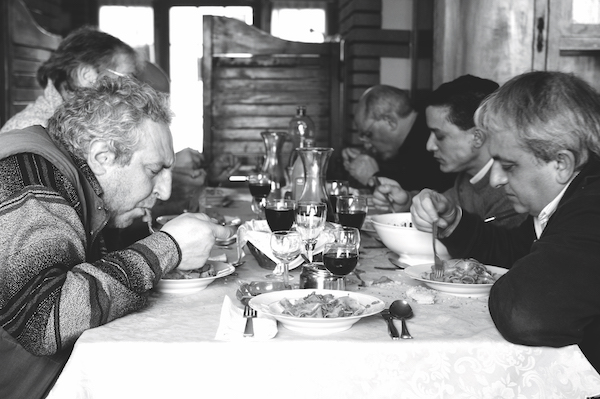
Everyone loves ‘spag bol’. It’s possibly Britain’s favourite meal. Yet many people would be surprised to learn that this ‘Italian’ recipe does not exist in Italy. Over-cooked spaghetti drenched in minced beef and tomato sauce, or heaped with boulder-size meatballs, is a hybridization of a classic Italian sauce, ragù alla bolognese. In its true form there isn’t a meatball in sight, and the tomato is conspicuous by its relative absence. Serve the sauce over fresh egg tagliatelle and you have a dish that is economical, sublime and true to its place of origin on the plains of Emilia-Romagna. 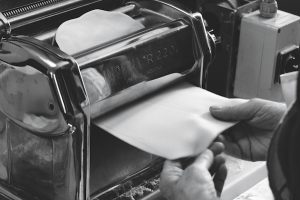
In many respects Italians do have a tendency towards ambiguity. They seldom like to lay their cards on the table – at least not until they know what’s in the deck! But when it comes to matters of the menu, they are less equivocal. ‘What’s in a name?’, you may ask. Well, it’s like this: if I’m in Milan, I can go to any restaurant, order a plate of risotto alla milanese and know exactly what to expect. My sons can order a costoletta – a veal cutlet – and I know what they’ll get. If I’m down south in the summer, I can order an insalata caprese and know that the light lunch won’t have me rushing to the hotel for a siesta. The Italian menu is, in effect, a road map – one that’s easy to navigate (once you know how to read it), and one that always keeps you on track.
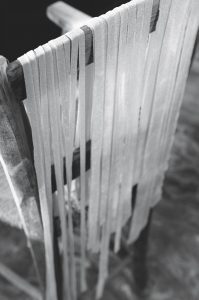 However, take the map out of Italy and somehow something gets lost in translation. In a moment of nostalgia on a recent trip abroad, I had a craving for a taste of home. I found an Italian restaurant and ordered a carbonara. It’s a classic, so how could I go wrong? Besides, I’ve spent enough time in professional kitchens to recognise the shortcuts. The likelihood was they might substitute the guanciale (cheek) with pancetta, but I was prepared to live with that. As it turned out, they used a processed cooked ham, which I wasn’t prepared for. Neither had I expected the half litre of UHT long-life cream the chef had decided to drown the spaghetti in! What’s more, he’d bombarded it with parsley. “It’s the sauce,” the waiter explained, completely missing my point. “Fine,” I said, (though it wasn’t), and wished I’d asked for the pizza. “Can you please bring me the bill and a ticket for the first plane home?”
However, take the map out of Italy and somehow something gets lost in translation. In a moment of nostalgia on a recent trip abroad, I had a craving for a taste of home. I found an Italian restaurant and ordered a carbonara. It’s a classic, so how could I go wrong? Besides, I’ve spent enough time in professional kitchens to recognise the shortcuts. The likelihood was they might substitute the guanciale (cheek) with pancetta, but I was prepared to live with that. As it turned out, they used a processed cooked ham, which I wasn’t prepared for. Neither had I expected the half litre of UHT long-life cream the chef had decided to drown the spaghetti in! What’s more, he’d bombarded it with parsley. “It’s the sauce,” the waiter explained, completely missing my point. “Fine,” I said, (though it wasn’t), and wished I’d asked for the pizza. “Can you please bring me the bill and a ticket for the first plane home?”
Italians need reassurance when they visit a restaurant. They are not adventurous when it comes to matters of the table and seldom stray far from familiar territory. We are also fiercely proud of our culinary heritage. In Italy, the term campanilismo is used to describe provincial heritage and pride. And local pride is founded upon local cuisine. In other words, the classic Italian dishes have provenance, one that is steeped in history, culture and territory, and these factors have made the classics what they are.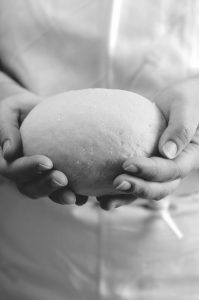
So you can appreciate why someone from Bologna might get irritated if they order ragù alla bolognese and are confronted with red spaghetti and meatballs. Similarly, if you want to befriend someone from Milan, don’t serve them a costoletta alla milanese unless: (a) the meat is veal, and (b) it comes on a bone. Otherwise, call it what it is: breaded chicken, an ‘elephant’s ear’ (if it’s veal minus the bone), or a pork chop.
Don’t get me wrong, I’m not the food police. I’m all for experimentation in the kitchen. From time to time, on a Sunday I will even cook my sons meatballs. But they won’t be served on spaghetti, and I certainly wouldn’t deceive them by labelling it as anything to do with Bologna.
Call food what it is. If you ask your butcher for veal, you wouldn’t expect him to give you steak. If I order costoletta alla milanese at a restaurant, I do not expect breaded chicken breast. Vero Italiano – the theme of this series of articles – means back to basics, a no-gimmicks look at how Italians really eat. In these features, we’ll visit the agriturismo, the salumeria and the caseificio (cheesemaker). We’ll spend time with Italians in the kitchen, in the trattoria and at the pizzeria. We’ll dine with them through the seasons, during the week, on Sundays and on feast days. We will unearth the truth of how and what Italians really cook and eat. And where to begin? With the classics of course!
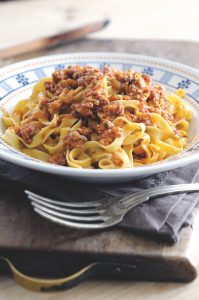
Bolognese ragù (Ragù alla bolognese)
One of the world’s most popular recipes, and also one of the most abused of the Italian classics. As its name implies, it is not, strictly speaking a dish, but rather a sauce that originated in Bologna. It uses lesser cuts of meat, and derives from cucina povera. It would not be served on a daily basis, but rather reserved for special occasions. There are so many versions of this dish that in the 1970s the Chamber of Commerce for Bologna decided to collect (in collaboration with l’Accademia Italiana della Cucina di Bologna) the various versions. The official recipe was recorded on 17 October 1982 in Bologna’s Chamber of Commerce. The recipe uses milk in the cooking, which some might find odd. What’s more, it requires a lengthy cooking time – so it’s one for a leisurely Sunday lunch. Give it a try. The aroma is magnificent, and I promise you’ll never look at ‘spag bol’ in the same way again!
Click here for Mario’s authentic bolognese ragù recipe.
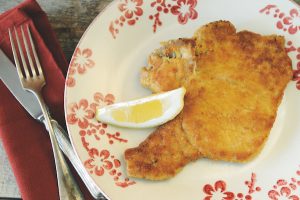
Milanese veal cutlet (Costoletta alla milanese)
Italians don’t want to concede that the wiener schnitzel, (the Austrian version of the costoletta alla milanese) came first, and we do have documentary evidence on our side. The costoletta is mentioned on a menu dated 1134 at a meal offered by an abbot to the clergy of Sant’Ambrogio in Milan. Costoletta alla milanese was given Denominazione Comunal (De.Co.) status on 17 February 2008. There is ongoing dispute as to the proper name – costoletta or cotoletta. (You say ‘potato’, I say ‘potaato’!) Personally, I don’t think it matters.
Click here for Mario’s authentic Milanese veal cutlet recipe.
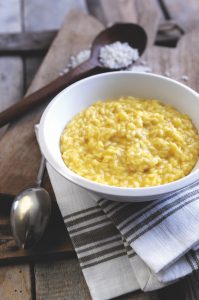
Milan’s saffron risotto (Risotto alla milanese)
This famed dish was first recorded on 8 September 1574, and is attributed to the wedding of the daughter of Flemish master glazer Valerio di Fiandra. Valerio was working on the stained glass windows of Milan’s cathedral. In tribute to his work, or perhaps as a joke, the chefs prepared a rice dish infused with saffron, which was used by glazers to stain windows. Risotto alla milanese was granted De.Co. status by the City of Milan in 2007. There are a number of acceptable variations. Some chefs add 20g of dried porcini mushrooms, others shavings of white truffle to the finished dish. In restaurants outside Milan, I’ve had this without the beef marrow. It’s a shortcut; the marrow gives greater depth. What is important is that you should: never add wine (it kills the saffron); use Italian rice; use butter, not oil; and a good stock. The sign of success is when the rice is cooked all’onda – it forms waves if you gently shake the plate. A risotto should be creamy and soft, but not loose – it’s not a soup. Each grain of rice should be separate but joined together by the sauce. Risotto should be eaten with a spoon, a glass of red wine, and with extra freshly grated parmesan cheese served at table.
Click here for Mario’s authentic saffron risotto recipe.
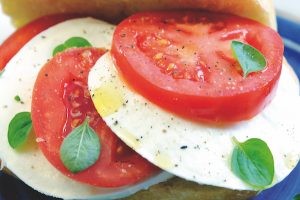
Mozzarella, tomato and basil salad (insalata caprese)
The success of insalata caprese lies in simplicity and quality ingredients. Its origins remain unclear. It is claimed that it was mentioned on a menu in the 1920s and that the tricolore formed by the mozzarella, tomatoes and basil appealed to the Nationalist movement, and thus insalata caprese began its illustrious career. Others say that in the 1950s, King Farouk of Egypt requested ‘something light’ after a day at the beach at Marina Piccola on Capri. He was served a warm panino stuffed with insalata caprese with fresh oregano. Whatever its origins, when it’s made with the right ingredients, there is no better salad.
Click here for Mario’s authentic mozzarella, tomato & basil salad recipe.
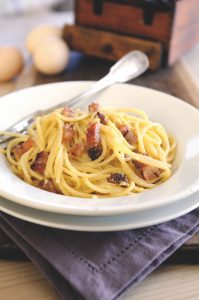
Spaghetti carbonara (spaghetti alla carbonara)
The history of carbonara is very short. There’s no reference to it in cook books over 50 years old, at least not with this name. There are many stories, of varying credibility, which claim to explain its origins. The name carbonara derives from carbone, charcoal. So, one theory says it was how Roman charcoal burners cooked pasta. Others attribute it to the carbonari – the insurgents who fought for independence from the Austrians 200 years ago. Others say it was invented for American soldiers in Rome after WWII. This latter is a nice story, but it doesn’t explain the name. There are a few acceptable variations. If you cannot get guanciale (cheek), pancetta works almost as well. I’ve been served this with parmesan instead of pecorino, but it’s not the same, and good pecorino is widely available. Also, leave the cream and parsley in the fridge – it doesn’t belong here.
Click here for Mario’s authentic spaghetti carbonara recipe.
